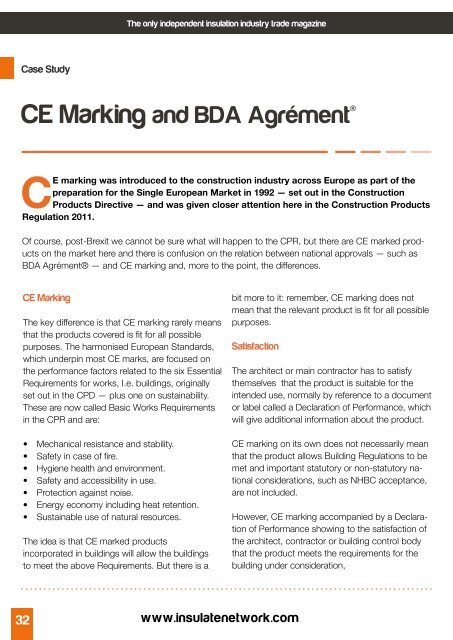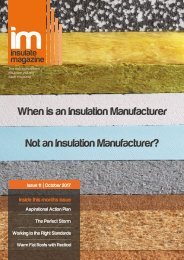Insulate Magazine Issue 10 - September 2017
Sound and acoustic insulation experts Soundis Sales Director Richard Hillman discusses the company history, product developments and more in an exclusive interview.
Sound and acoustic insulation experts Soundis Sales Director Richard Hillman discusses the company history, product developments and more in an exclusive interview.
You also want an ePaper? Increase the reach of your titles
YUMPU automatically turns print PDFs into web optimized ePapers that Google loves.
The only independent insulation industry trade magazine<br />
www.insulatenetwork.com<br />
Case Study<br />
CE Marking and BDA Agrément®<br />
CE marking was introduced to the construction industry across Europe as part of the<br />
preparation for the Single European Market in 1992 — set out in the Construction<br />
Products Directive — and was given closer attention here in the Construction Products<br />
Regulation 2011.<br />
Of course, post-Brexit we cannot be sure what will happen to the CPR, but there are CE marked products<br />
on the market here and there is confusion on the relation between national approvals — such as<br />
BDA Agrément® — and CE marking and, more to the point, the differences.<br />
CE Marking<br />
The key difference is that CE marking rarely means<br />
that the products covered is fit for all possible<br />
purposes. The harmonised European Standards,<br />
which underpin most CE marks, are focused on<br />
the performance factors related to the six Essential<br />
Requirements for works, I.e. buildings, originally<br />
set out in the CPD — plus one on sustainability.<br />
These are now called Basic Works Requirements<br />
in the CPR and are:<br />
bit more to it: remember, CE marking does not<br />
mean that the relevant product is fit for all possible<br />
purposes.<br />
Satisfaction<br />
The architect or main contractor has to satisfy<br />
themselves that the product is suitable for the<br />
intended use, normally by reference to a document<br />
or label called a Declaration of Performance, which<br />
will give additional information about the product.<br />
will be acceptable under Building Regulations.<br />
BDA Agrément®<br />
A BDA Agrément® addresses the different<br />
Building Regulations applicable to each part of<br />
the United Kingdom and NHBC criteria are also<br />
considered – in a single document.<br />
Durability is another key factor not addressed by<br />
CE marking but every BDA Agrément® contains<br />
a durability statement — vitally important information<br />
for architects, developers and building owners,<br />
letting them know how long the product is<br />
likely to last. Installation information is also absent<br />
from CE marking but there are installation details<br />
in all BDA Agréments.<br />
initial type testing and a management<br />
systems certification by a body notified for that<br />
purpose to the European Commission. Only<br />
products with key health and safety<br />
considerations need the involvement of a<br />
product certification body before CE marking<br />
can be applied.<br />
Kiwa BDA<br />
With all products approved by Kiwa BDA, testing<br />
is undertaken and the resulting data assessed<br />
by our experts, and if the approval is awarded<br />
the manufacturer is subject to continuing surveillance<br />
by our inspectors throughout the validity of<br />
the approval. This means specifiers, users and<br />
building owners can have total confidence that all<br />
products with a BDA Agrément® will be — and<br />
perform — exactly as set out in the document.<br />
A BDA Agrément® addresses the<br />
different Building Regulations applicable<br />
to each part of the United<br />
Kingdom and NHBC criteria are also<br />
considered – in a single document.<br />
• Mechanical resistance and stability.<br />
• Safety in case of fire.<br />
• Hygiene health and environment.<br />
• Safety and accessibility in use.<br />
• Protection against noise.<br />
• Energy economy including heat retention.<br />
• Sustainable use of natural resources.<br />
The idea is that CE marked products<br />
incorporated in buildings will allow the buildings<br />
to meet the above Requirements. But there is a<br />
CE marking on its own does not necessarily mean<br />
that the product allows Building Regulations to be<br />
met and important statutory or non-statutory national<br />
considerations, such as NHBC acceptance,<br />
are not included.<br />
However, CE marking accompanied by a Declaration<br />
of Performance showing to the satisfaction of<br />
the architect, contractor or building control body<br />
that the product meets the requirements for the<br />
building under consideration,<br />
Surveillance and inspection vary in CE marking<br />
depending on the nature of the product and its<br />
role in the building; the more health and safety<br />
critical, the more onerous the regime. At the<br />
lower end of the scale the manufacturer or importer<br />
can simply declare that the relevant product<br />
complies with the Standard and apply the CE<br />
mark, with no continuing surveillance.<br />
Most products will be CE marked on the basis of<br />
32 www.insulatenetwork.com<br />
insulatenetwork<br />
33













